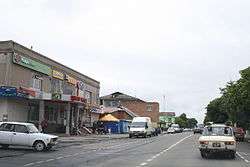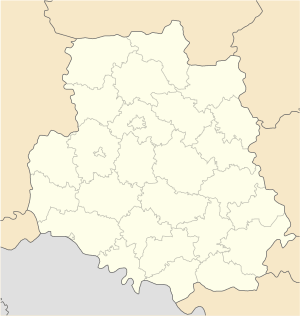Nemyriv
Nemyriv (Ukrainian: Немирів, Russian: Немирoв, Polish: Niemirów) is a historic town in Vinnytsia Oblast (province) in Ukraine, located in the historical region of Podolia. It is the administrative center of Nemyriv Raion (district). Population: 11,829 (2015 est.)[1]
Nemyriv Немирів | |
|---|---|
 Downtown Nemyriv | |
 Flag  Coat of arms | |
| Nickname(s): Peace Island City | |
 Nemyriv Location of Nemyriv  Nemyriv Nemyriv (Ukraine) | |
| Coordinates: 48°58′N 28°51′E | |
| Country Oblast Raion | Ukraine Vinnytsia Nemyriv |
| Population (2015) | |
| • Total | 11,829[1] |
| Area code(s) | +380 4331 |
Nemyriv is one of the oldest cities in Vinnytska oblast, Ukraine. It was founded by Prince Nemyr in 1390. It is a minor industrial center.
The distiller company that produces Ukrainian Nemiroff (Russian spelling) vodka is located in Nemyriv.
The town's tourist attractions include a late 19th-century palace (which belonged to the House of Potocki) and a park complex.
History
![]()
![]()
![]()
![]()
![]()
![]()
![]()
![]()
![]()

Nemyriv was built on the site of ancient Scythian settlement Myriv, destroyed during the Mongol invasion of Rus'. It was first mentioned under its modern name in 1506. It was a private town of Poland, owned by the families of Zbaraski and Potocki. Polish King Stanisław August Poniatowski visited the Potocki Palace.
Notable events of Cossack wars took place in the town through 17th century and the city was captured by Andrii Abazyn between 1702 and 1704.[2]
In 1737, an abortive congress was held in Nemyriv, aimed at the conclusion of peace between the emperors of Russia, Austria-Hungary, and Ottoman Turkey, and bringing an end to the Russo-Turkish War of 1735–39.
Jewish history of the city
Before World War II, Nemyriv had a large Jewish community. The Hasidic Rabbi Jacob Joseph of Polonne was appointed as rabbi in Nemyriv after he left Rashkov, during the 3rd quarter of the 18th century.[3][4] By the 19th century it had become one of the centers of Breslov Hasidism, being the birthplace and home of Nathan of Breslov ("Reb Noson"), the foremost disciple and scribe of rebbe Nachman of Breslov. After Nachman's death in 1810, Reb Noson moved to Bratslav to disseminate and publish his teachings from there. The city acted as a center of Jewish studies and linked with several Rabbi.Yom-Tov Lipmann Heller and Jehiel Michel ben Eliezer.[5] Yom-Tov Lipmann Heller once chief Rabbi of Vienna and Prague was the Chief Rabbi of Nemyriv from 1631 to 1634.
By September 1941, the German kept the Jews of the city prisoners in a ghetto, where they were put to work, constructing the road from Nemyriv to Gaysin. On November 24, 1941, an Einsatzgruppen massacred 2,680 Jews in pits in the Polish cemetery. On June 26, 1942, the ghetto was liquidated. The Jews were driven into the synagogue, where 200 to 300 young and strong men and women were selected and sent to a labor camp. The rest, perhaps as many as 500, were shot behind the Polish cemetery in pits that had been dug in advance.[6]
Gallery
 St. Joseph Catholic Church
St. Joseph Catholic Church Scherbatova Palace in Nemyriv
Scherbatova Palace in Nemyriv- Nemyriv gymnasium
- Old mill
Notable people
- Nathan of Breslov, rabbi
- Nikolay Nekrasov, poet
- Marko Vovchok, writer
- Theodosius Dobzhansky, geneticist
- Mordechai Namir, Israeli politician
- Ida Rhodes (birth name Hadassah Itzkowitz) was born in a Jewish village between Nemyriv and Tulchyn.
References
- "Чисельність наявного населення України (Actual population of Ukraine)" (PDF) (in Ukrainian). State Statistics Service of Ukraine. Retrieved 1 July 2016.
- Encyclopedia of Ukraine
- Dresner, Samuel H. (Rabbi). The Zaddik: The Doctrine of the Zaddik according to the Writings of Rabbi Yaakov Yosef of Polnoy, Shocken Books, 1974.ISBN 0-8052-0437-7 p. 50 (mention of his stay in Nemirov).
- Encyclopædia Britannica
- Jewish Encyclopedia.com
- http://yahadmap.org/#village/nemyriv-vinnytsia-ukraine.192
External links
- The murder of the Jews of Nemyriv during World War II, at Yad Vashem website.